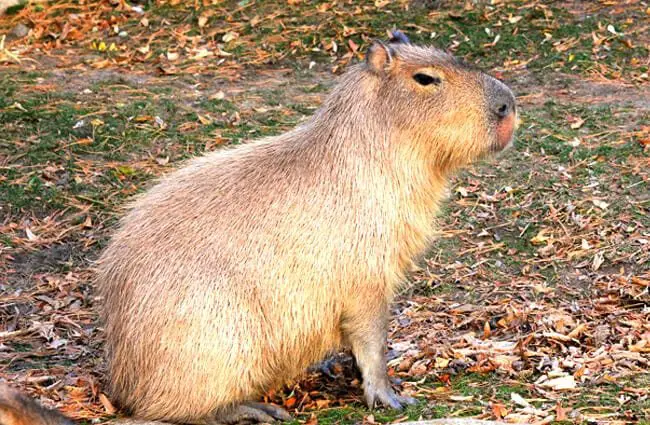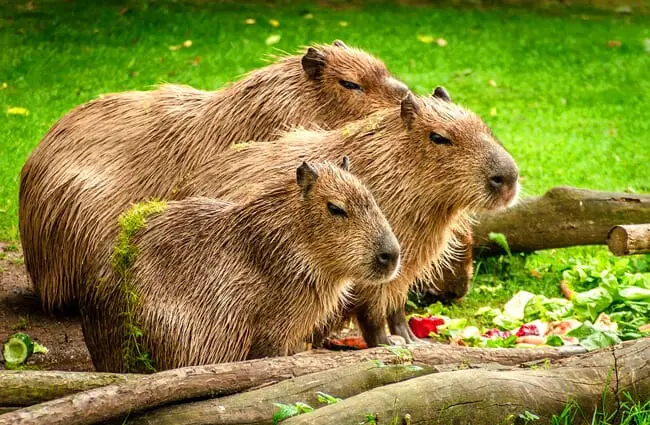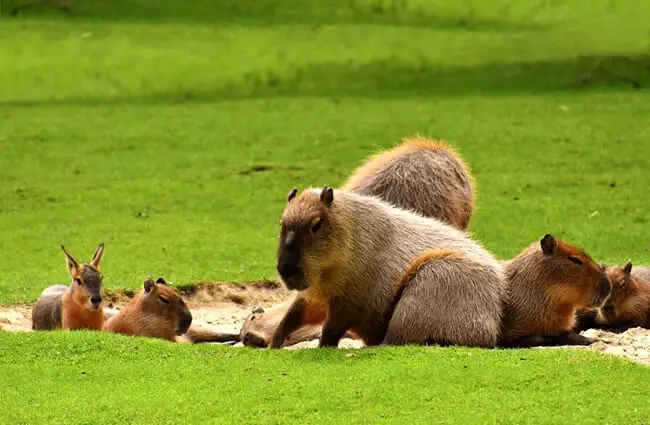In the vast tapestry of the animal kingdom, some creatures simply stand out. Among them, the capybara, often described as the world’s largest rodent, holds a special, endearing place. With its calm demeanor, semi-aquatic lifestyle, and surprisingly social habits, this gentle giant from South America has captured the hearts of many, from seasoned zoologists to casual animal enthusiasts. Let us embark on a journey to uncover the fascinating world of the capybara, exploring its biology, behavior, and its vital role in the ecosystems it calls home.
The Capybara Unveiled: A Gentle Giant’s Profile
The capybara, scientifically known as Hydrochoerus hydrochaeris, is an animal of impressive stature. It is not just the largest rodent alive today, but also a creature perfectly adapted to its watery environment. Imagine a guinea pig, but scaled up to the size of a medium-sized dog, and you begin to get a picture of this unique mammal.
Physical Characteristics and Classification
Adult capybaras typically weigh between 77 and 146 pounds (35 to 66 kg) and can stand up to 2 feet (60 cm) tall at the shoulder, reaching lengths of over 4 feet (1.2 meters). Their bodies are robust and barrel-shaped, covered in coarse, reddish-brown to grayish fur. A distinctive feature is their partially webbed feet, equipped with short, strong claws, which are invaluable for navigating both muddy riverbanks and swimming through water. Their eyes, ears, and nostrils are positioned high on their heads, allowing them to remain almost entirely submerged while still being able to see, hear, and breathe. This adaptation is crucial for their survival, offering both camouflage and a quick escape route from predators.
As rodents, capybaras possess continuously growing incisors, which they keep trimmed by constantly grazing on tough vegetation. They belong to the family Caviidae, which also includes guinea pigs and maras, highlighting their evolutionary kinship with these smaller, more familiar rodents.

Habitat and Distribution: Where to Find a Capybara
Capybaras are endemic to South America, thriving across a vast range from Panama in the north down to Argentina in the south. Their preferred habitat is intrinsically linked to water. They are semi-aquatic mammals, meaning they spend a significant portion of their lives in and around water bodies. Ideal capybara habitats include:
- Rivers
- Lakes
- Swamps
- Ponds
- Marshes
- Estuaries
These areas provide not only a constant source of water for drinking and cooling but also lush vegetation for grazing and crucial refuge from predators. They are particularly abundant in the Pantanal wetlands of Brazil, Bolivia, and Paraguay, as well as the Llanos grasslands of Venezuela and Colombia. An animal lover hoping to spot a capybara in the wild should focus their search on these regions, particularly near the edges of water bodies during dawn or dusk when the animals are most active.
Diet: The Grazing Giant’s Menu
As herbivores, capybaras primarily feed on grasses and aquatic plants. Their diet is quite specialized, consisting mainly of various types of grasses, which they graze much like cattle. They are selective eaters, preferring certain species of grasses and sedges. During the dry season, when fresh grasses become scarce, they may broaden their diet to include:
- Aquatic vegetation
- Tree bark
- Fruits
Capybaras are also known to practice coprophagy, consuming their own feces. This behavior is not uncommon among herbivores and serves a vital purpose: it allows them to re-ingest partially digested food, extracting maximum nutrients from their fibrous diet, particularly cellulose. This makes their digestive system highly efficient at processing tough plant matter.

Social Structure: The Herd Mentality
Capybaras are highly social animals, typically living in groups ranging from 10 to 20 individuals, though much larger aggregations can be observed during the dry season when animals concentrate around dwindling water sources. These groups are usually led by a dominant male, accompanied by several females, their offspring, and subordinate males. Communication within the group involves a variety of vocalizations, including:
- Barks
- Whistles
- Purrs
- Grunts
They also communicate through scent marking, using glands located on their snouts (males have a prominent scent gland called a morrillo) and anal glands to mark territory and convey social status. Their strong social bonds are evident in their communal behaviors, such as grooming each other and sharing vigilance against predators.
Deeper Dive: Evolution, Reproduction, and Ecological Role
Evolutionary Journey: A Glimpse into the Past
The evolutionary history of the capybara is a fascinating chapter in the story of South American fauna. As members of the Caviidae family, their lineage can be traced back millions of years. Fossil records indicate that ancient relatives of the capybara were even larger, with some extinct species reaching sizes comparable to a bear. This suggests a trend of gigantism among South American rodents during the Cenozoic era. The capybara’s adaptations for a semi-aquatic lifestyle, such as its high-set eyes and webbed feet, are testament to a long evolutionary process driven by the availability of water-rich environments and the need to evade terrestrial predators.
Reproduction and Life Cycle
Capybaras are prolific breeders, with reproduction occurring year-round, though peaks are often observed during the rainy season when food is abundant. The mating process typically takes place in the water. After a gestation period of approximately 150 days, females give birth to a litter of usually two to eight precocial young. Precocial means the young are born relatively well-developed, with fur, open eyes, and the ability to walk and swim shortly after birth.

The young capybaras are nursed by their mother for several months but begin to graze on grasses within a few weeks. They remain with the group, benefiting from the protection and social learning opportunities it provides. Sexual maturity is reached around 15 to 18 months of age. In the wild, capybaras typically live for 6 to 10 years, though their lifespan can be longer in captivity.
Ecosystem Role: Nature’s Lawn Mowers and More
Capybaras play a significant role in their ecosystems, acting as key herbivores and influencing the structure of vegetation. Their constant grazing helps to maintain grasslands and prevent overgrowth, effectively acting as “nature’s lawn mowers.” This grazing also impacts plant diversity and nutrient cycling within their habitats. Beyond their direct impact on vegetation, capybaras are a crucial food source for a variety of predators, including:
- Jaguars
- Pumas
- Anacondas
- Caimans
- Harpy Eagles (preying on young)
Their presence supports these predator populations, contributing to the overall balance of the food web. Furthermore, by moving between water and land, they can facilitate seed dispersal, further contributing to the ecological dynamics of their environment.

Interaction with Other Species
Capybaras are known for their remarkably calm and tolerant nature, often seen coexisting peacefully with a variety of other species. It is not uncommon to observe birds perched on their backs, feeding on ticks and other parasites, a classic example of a commensal or mutualistic relationship. They share their aquatic habitats with various fish, amphibians, and reptiles, and their presence can even create microhabitats that benefit smaller creatures. Their vigilance also provides a form of early warning system for other animals in their vicinity, as their alarm barks can signal the approach of a predator.
Capybaras and Humans: Encounters and Care
Capybaras and Human Culture
The capybara’s unique charm has not gone unnoticed by human culture. In some parts of South America, particularly Venezuela, capybaras are traditionally hunted for their meat and hide, and their fat is used for medicinal purposes. However, in recent years, their image has shifted globally. They have become popular figures in internet memes and social media, celebrated for their placid demeanor and seemingly friendly interactions with other animals. This surge in popularity has fostered a greater appreciation for these animals and contributed to conservation efforts.
Interactions with Humans: From Wild Encounters to Captive Care
The relationship between capybaras and humans is multifaceted, ranging from respectful coexistence in the wild to careful management in zoological settings.
Encountering a Capybara in the Wild: What to Do
For hikers or nature enthusiasts fortunate enough to encounter a capybara in its natural habitat, the experience can be truly memorable. Capybaras are generally docile and not aggressive towards humans. However, like all wild animals, they should be treated with respect and caution. Here are some guidelines:
- Maintain Distance: Always observe from a respectful distance. Do not attempt to approach or touch them.
- Avoid Feeding: Never offer food to wild capybaras. This can alter their natural foraging behaviors and make them dependent on humans.
- Observe Quietly: Move slowly and speak softly to avoid startling the animals.
- Respect Their Space: If a capybara appears agitated or tries to move away, allow it to do so without pursuit.
- Be Aware of Surroundings: Remember that capybaras are prey animals, and their presence might indicate the presence of predators like jaguars or caimans in the area.
Enjoy the opportunity to witness these magnificent rodents in their natural environment, but always prioritize their well-being and your safety.
Caring for Capybaras in Captivity: A Zookeeper’s Guide
Caring for capybaras in a zoological setting requires a deep understanding of their natural history and specific needs. Zookeepers play a crucial role in ensuring their welfare. Key tasks and considerations include:
- Habitat Design:
- Provide a spacious enclosure with ample access to a clean, freshwater pool or pond for swimming, cooling, and defecation.
- Ensure both sunny and shaded areas are available.
- Offer soft ground or grassy areas for grazing and resting.
- Include hiding spots or shelters for security.
- Dietary Management:
- Offer a diet primarily consisting of high-quality grass hay, supplemented with fresh greens, vegetables, and a specialized rodent or herbivore chow.
- Monitor for selective eating and adjust as needed.
- Ensure constant access to fresh water.
- Social Structure:
- House capybaras in social groups, mimicking their natural herd structure.
- Monitor group dynamics to prevent aggression, especially among males.
- Enrichment:
- Provide environmental enrichment to stimulate natural behaviors, such as floating toys in their pool, browse material, or puzzle feeders.
- Offer opportunities for digging and wallowing.
- Health Monitoring:
- Regular veterinary check-ups are essential.
- Pay close attention to dental health, as their continuously growing teeth can cause issues if not properly worn down.
- Monitor for skin conditions, especially those related to prolonged water exposure or parasites.
- Ensure proper vaccination and deworming protocols.
- What to Avoid:
- Overcrowding in enclosures.
- Diets high in sugary fruits or processed foods, which can lead to dental and digestive problems.
- Isolation, as they are highly social animals.
- Lack of access to water, which is critical for their thermoregulation and skin health.

Fascinating Capybara Facts
Here is a collection of intriguing facts that highlight the capybara’s unique attributes:
- Excellent Swimmers: Capybaras can hold their breath underwater for up to five minutes, using this ability to escape predators or simply to cool off.
- Natural Sunscreen: Their skin secretes an oily, protective substance that helps keep their fur waterproof and protects them from the sun.
- Sleep in Water: They often sleep in the water, with only their nostrils exposed, a clever adaptation for safety and comfort.
- Unique Vocalizations: Capybaras have a surprisingly wide range of sounds, including barks that resemble a dog’s, purrs, and clicks.
- Fast Runners: Despite their bulky appearance, capybaras can run quite fast on land, reaching speeds of up to 22 miles per hour (35 km/h) over short distances.
- Herbivore Specialists: Their digestive system is highly specialized to process tough grasses, making them efficient grazers.
- Rodent Relatives: They are closely related to guinea pigs and rock cavies, sharing a common ancestor.
- Communal Parenting: While mothers nurse their own young, all females in a group may participate in caring for the entire litter, demonstrating strong communal bonds.
- “Water Pig” Name: The name “capybara” comes from the Tupi language, meaning “one who eats slender leaves,” while their scientific name Hydrochoerus translates to “water pig.”
Conclusion: The Enduring Appeal of the Capybara
From its humble beginnings as a large rodent to its current status as a beloved icon of the animal kingdom, the capybara continues to fascinate and inspire. Its unique adaptations, complex social structures, and vital ecological role underscore the intricate beauty of nature. Whether observed in the wild, studied by aspiring zoologists, or cared for by dedicated zookeepers, the capybara offers endless opportunities for learning and appreciation. As we continue to understand and protect these remarkable creatures, we ensure that the gentle giants of the wetlands will continue to thrive for generations to come, reminding us of the wonder that exists in the natural world.

![Red Angus Closeup of a beautiful Red Angus cowPhoto by: U.S. Department of Agriculture [pubic domain]https://creativecommons.org/licenses/by/2.0/](https://animals.net/wp-content/uploads/2020/03/Red-Angus-4-238x178.jpg)




![Red Angus Closeup of a beautiful Red Angus cowPhoto by: U.S. Department of Agriculture [pubic domain]https://creativecommons.org/licenses/by/2.0/](https://animals.net/wp-content/uploads/2020/03/Red-Angus-4-100x75.jpg)

